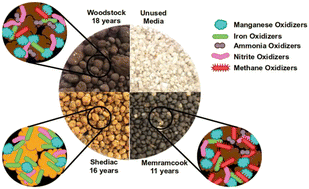Understanding the impact of different source water types on the biofilm characteristics and microbial communities of manganese removing biofilters†
Abstract
There is growing regulatory interest for Mn in drinking water due to health concerns and an improved understanding of Mn accumulation within distribution systems. Biofiltration can remove Mn from drinking water through biological mechanisms, including oxidation of dissolved Mn(II) by manganese oxidizing bacteria. The influence of source water type (groundwater vs. a mixture of groundwater/surface water) on the composition of filter media biofilm was investigated in three full-scale biofilters which have a history of sustained Mn removal in New Brunswick, Canada. Each location used the same treatment design, including upstream aeration and media type and depth, which removed many variables that may make it difficult to isolate the impact of source water type specifically. The average raw water Mn, Fe, and NH3 concentrations ranged from 370–950 μg L−1, 35–2070 μg L−1, and 0.03–0.04 mg L−1 respectively. The average Mn, Fe, and NH3 removal rates ranged from 98–99%, 78–98%, and 12–54% respectively. Mn, Fe, NH3, NO2−, and CH4 oxidizing microbial communities were characterized in detail through 16S rRNA marker gene sequencing. Although there was little difference in biofilter influent water chemistry, the raw water active biomass was significantly greater (p < 0.05) in the mixed-water biofilter and the mixed-water microbial community was distinct from the groundwater microbial community (p < 0.001). Additionally, active biomass on the surface of biofilter media was significantly greater (p < 0.001) in the mixed-water biofilter, and there were significant differences in extracellular polymeric substance (EPS) composition (protein: p < 0.001, carbohydrate: p < 0.05) between source water types. Few studies have examined surface water Mn removing biofilters, which may lead utilities to apply conclusions generated from groundwater Mn removing biofilters to surface water biofilters. However, this study suggests that despite similar treatment designs, influent water quality, and Mn removal performance, the composition of the EPS and microbial community within Mn removing biofilters can be significantly affected by source water type.



 Please wait while we load your content...
Please wait while we load your content...